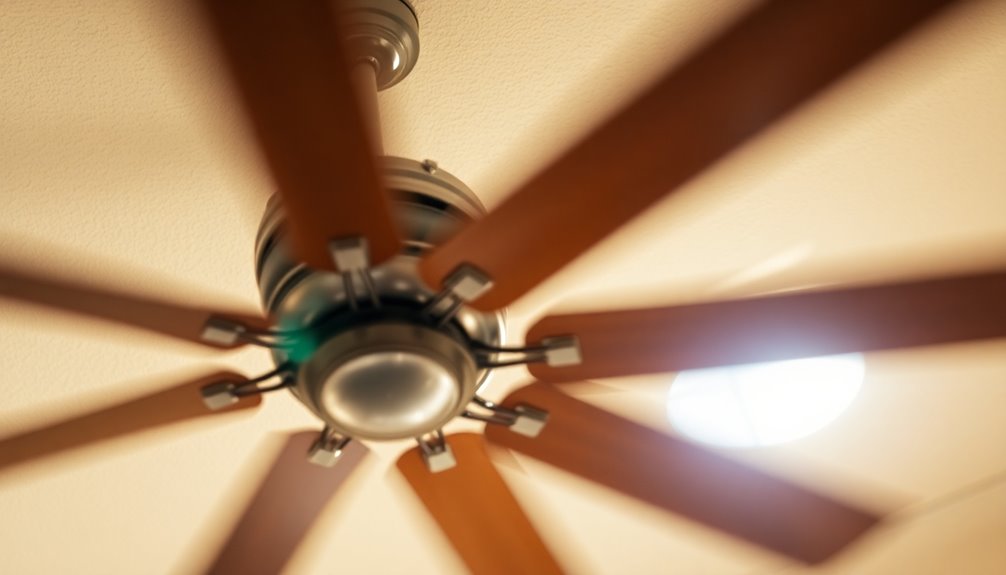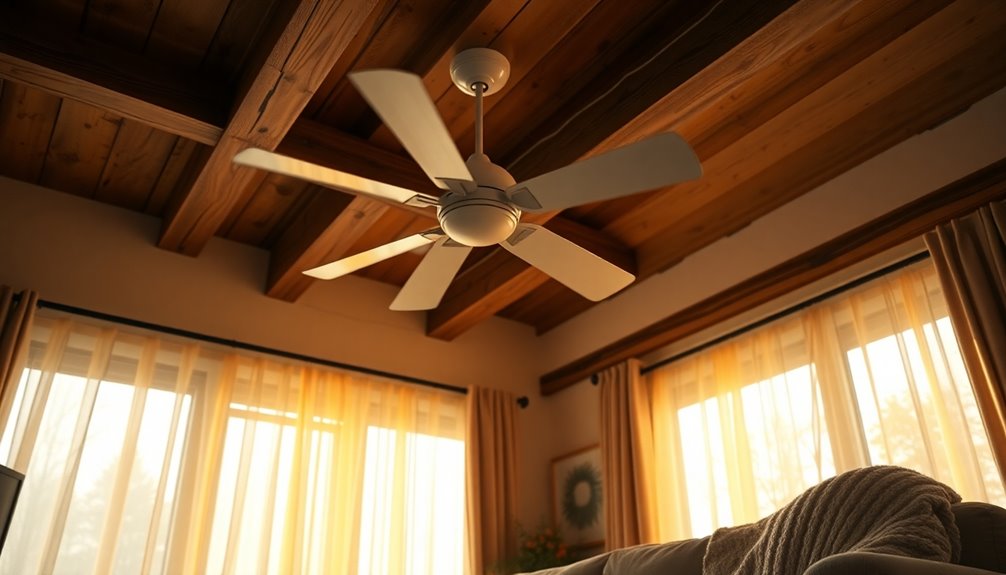To choose the right ceiling fan size, start by measuring your room's square footage. For small rooms up to 100 sq ft, go for fans with a diameter of 29-36 inches. In medium rooms (up to 400 sq ft), pick fans of 48-54 inches. Large rooms (over 400 sq ft) require fans with a 50-71 inch diameter. Also, consider your ceiling height; flush mount fans work best for ceilings under 8 feet, while downrods help optimize airflow in higher spaces. By understanding these key points, you'll set the stage for your perfect fan choice. Discover more tips and options to enhance your selection!
Key Takeaways
- Measure your room's length and width to calculate the square footage for accurate fan size selection.
- Use 29-36 inch fans for small rooms (up to 100 sq ft) and 48-54 inch fans for medium rooms (up to 400 sq ft).
- For large rooms (over 400 sq ft), opt for fans 50-71 inches in diameter or consider multiple smaller fans.
- Ensure the fan blades are about 8 feet above the floor, using flush mounts for ceilings under 8 feet and downrods for higher ceilings.
- Maintain at least 18 inches of clearance between fan blades and walls for optimal airflow and performance.
Determining Room Size

To figure out the right size for your ceiling fan, you'll want to start by measuring your room. First, measure the length and width to calculate the square footage (length x width). This number will guide you in selecting the appropriate ceiling fan sizes.
For small rooms, which cover up to 100 square feet, you'll want small ceiling fans with a diameter of 29-36 inches for maximum airflow. If your room is a medium size, up to 400 square feet, you should choose a fan with a diameter of 48-54 inches to guarantee effective air circulation.
For larger rooms, those over 400 square feet, go for fans with a diameter of 50-71 inches to provide adequate airflow coverage. If your space has an L-shape, don't worry. Just divide it into two rectangles, calculate the square footage for each, and add them together to determine the total room size.
Also, remember to measure the height from the floor to where you plan to install the fan, as this can affect air circulation. By understanding your room size, you can make the best choice for your ceiling fan.
Recommended Fan Sizes

How do you choose the right ceiling fan size for your space? Using a ceiling fan size guide can help you make the best choice.
For small rooms up to 100 square feet, like a cozy bedroom or home office, you'll want a fan with a diameter between 29 to 36 inches for ideal air circulation.
If your room measures up to 400 square feet, a medium room fan with a diameter of 48 to 54 inches is recommended to guarantee effective airflow.
For large rooms exceeding 400 square feet, consider fans with a diameter of 50 to 71 inches for sufficient cooling and heating support.
For example, in a 12×12 room, a fan size between 36 to 50 inches will provide ideal performance.
If you're dealing with very large spaces, you might want to think about using multiple smaller fans. This approach ensures even air distribution throughout the area, enhancing the overall airflow.
Ceiling Height Considerations

When installing a ceiling fan, considering the height of your ceiling is essential for achieving satisfactory airflow and safety. The ideal height for ceiling fan blades is around 8 feet above the floor. In rooms with ceilings under 8 feet, you'll want to use low-profile or flush mount fans to maintain safe clearance and effective air circulation.
For ceilings over 9 feet, a downrod is typically required to lower the fan to the appropriate height for effective airflow. Aim for a hanging height between 8 to 9 feet. Additionally, verify there's at least 18 inches of clearance between the fan blades and walls to avoid obstructions.
Here's a summary to guide you:
| Ceiling Height | Recommended Mounting | Downrod Length |
|---|---|---|
| Under 8 feet | Flush mount | N/A |
| 8 to 9 feet | Standard mount | N/A |
| Over 9 feet | Standard mount | Calculate based on ceiling height |
| 10 feet | Standard mount | Length = Ceiling Height – Fan Height – 8 |
| 12 feet | Standard mount | Length = Ceiling Height – Fan Height – 8 |
Fan Mounting Options

Choosing the right fan mounting option is vital for guaranteeing ideal performance and safety in your space.
If your ceiling height is under 8 feet, a flush mount is your best bet. This option keeps the fan close to the ceiling, maximizing your room's space while still providing effective air circulation.
For ceilings over 8 feet, downrod mounting is the way to go. You'll need to select an appropriate downrod length to achieve a hanging height of 8-9 feet, which is essential for optimal airflow.
If you have vaulted ceilings, it's important to use downrods as well, adjusting for the slope's angle to make sure the fan hangs at the right height.
Always remember to maintain at least 18 inches of clearance between the fan blades and walls to prevent obstructions that could hinder performance.
Before finalizing your choice, check both your ceiling height and the fan specifications to confirm safe and effective installation.
Style and Aesthetics

After you've settled on the right mounting option for your ceiling fan, the next step is to contemplate its style and aesthetics. Your choice of ceiling fan style should harmonize with your room's existing decor—whether you lean toward modern, traditional, rustic, or industrial designs.
Consider how the finishes of the fan blades and motor, like natural wood, black, or metallic, align with your interior color scheme for a cohesive look.
The shape and number of fan blades can greatly influence both aesthetics and airflow efficiency. Most ceiling fans feature between 4 to 9 blades, which can vary in shape to enhance the overall design.
If you're looking for added functionality, explore modern ceiling fans that come with integrated lighting options. These can enhance both style and illumination, allowing you to choose between a minimalist look or something more ornate.
Additionally, opting for fans with reversible blades offers design versatility, letting you switch up the fan's appearance to match seasonal decor changes.
Frequently Asked Questions
Is a 52 Inch Fan Too Big for a 12X12 Room?
A 52-inch fan's likely too big for your 12×12 room. You might find that the airflow becomes overpowering, making it uncomfortable.
Instead, you should consider a fan between 36 to 44 inches for ideal comfort and air circulation.
Also, be mindful of ceiling height and clearance, as a larger fan could create mounting issues.
Choosing the right size will help you enjoy a pleasant, cool atmosphere without overwhelming your space.
How Do I Choose the Right Size Ceiling Fan?
Choosing the right size ceiling fan involves measuring your room and considering airflow needs.
For small spaces up to 100 square feet, go for a fan with a diameter of 29 to 36 inches.
Medium rooms, between 100 to 400 square feet, need fans that are 48 to 54 inches.
In larger areas, pick a fan that's 56 inches or larger.
Always check the longest wall length to guarantee a perfect fit!
What Size Room Is a 52 Ceiling Fan For?
Imagine your room as a dance floor, where a 52-inch ceiling fan leads the way, twirling cool air across medium to large spaces.
You'll find it perfect for areas between 144 to 400 square feet—think living rooms or dining areas.
With blades positioned 8 to 9 feet from the ground, it'll create an invigorating breeze, ensuring everyone enjoys the rhythm of comfort, especially in spaces like 12×12 feet to 20×20 feet.
Is a 3/4 or 5 Blade Ceiling Fan Better?
When choosing between a 3-blade or 5-blade ceiling fan, it really comes down to your needs.
If you prefer a modern look with higher airflow efficiency, a 3-blade fan might be your best bet.
However, if you want quieter operation and steady air circulation, especially for larger spaces, you might lean towards a 5-blade option.
Think about your room size, design preferences, and what airflow characteristics you value most before deciding.
Conclusion
Now that you know how to determine the right ceiling fan size for your space, imagine the perfect blend of comfort and style awaiting you. Picture a room where the air flows freely, and the ambiance feels just right. But wait—what if your choice could elevate your entire home's look? Don't rush into a decision; consider all factors carefully. You're just one fan away from transforming your space into a haven of coolness and charm. What will you choose?








